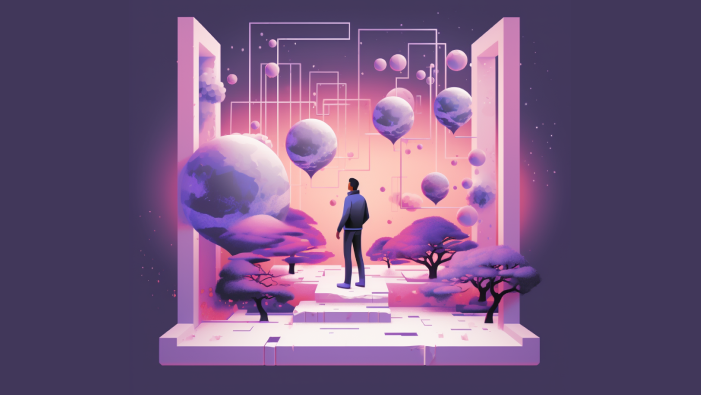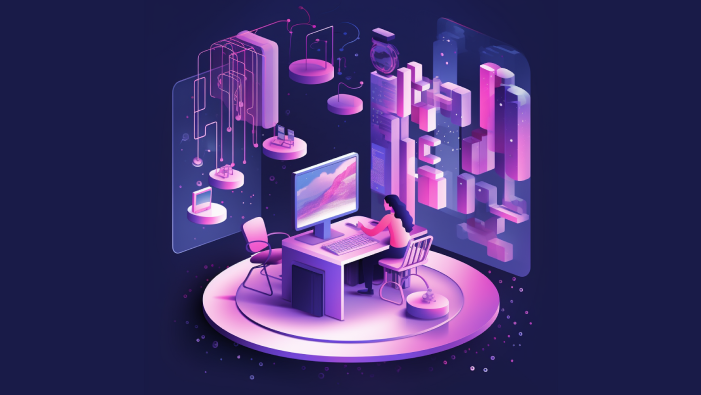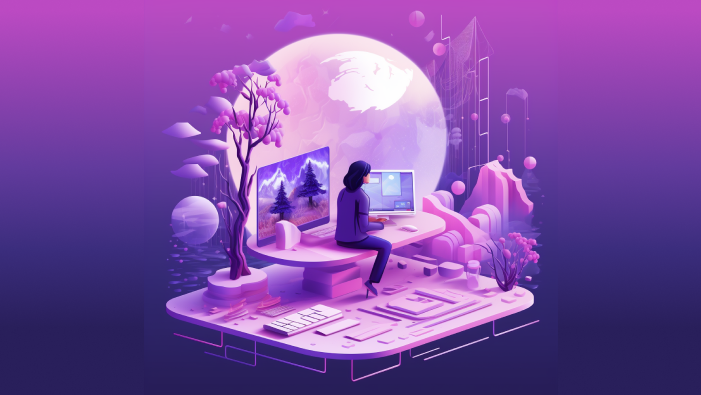


Author: Bob Jan 07, 2025 11 min read
Spatial computing is creating a real buzz in the world of technology, business, and consumer tech market. We are going to witness an era of spatial computing in its evolving form?
Below, we will discover a whole world of a new era of physical and virtual environments, give a special computing definition, compare Vision Pro and Magic Leap technologies, and finally, explore virtual experiences in the business world in 2025.
Have you ever played video games? What if you could participate in a game directly, interacting with the environment, objects, and characters, talking to them, and getting a response? This is a simple spatial computing example where virtual reality (VR) and augmented reality (AR) meet the physical world.
Speaking more professionally, spatial computing is a technology that allows for interacting with the physical world in a more immersive and interactive way by overlaying digital content into the physical environment. Apple CEO Tim Cook called it “an innovation that combines digital content with physical space, allowing the user’s eyes to stay connected to other participants.”
In the business world, the existence of a new extended reality brings the following benefits:
Spatial computing offers numerous business ideas with less cost and higher safety, like virtual events and conferences.

The spatial computing market has taken center stage since new technologies were introduced.
A new form of computing has the potential to transform how we interact with technology and the world around us, leading to new opportunities and innovations. So, let’s review the main trends that shape the spatial computing presentence in 2025.
The spatial computing is becoming more vital, with more companies and individuals using it for various purposes. The global market for new computing forms is expected to reach $512 billion by 2032.
For example, as stated by Forbes, the technology has the potential to revolutionize real-time training and skill development that helps to enhance the learning and performance of employees and workers. This was evident at CES 2024, where PIXO VR and Dimension X announced the creation of a digital content creation platform that allows enterprises to utilize various AR/VR/MR spatial computing applications to meet their training needs.
Magic Leap One is the first prominent mixed reality headset to speak out loud about human interactions in the expanding computing world. The headset combines sensors, high-speed cameras, two lenses, a 3D audio system Spatial Audio, a 3.5 mini-jack, and a mike.
Magic Leap Two, an evolving form of the previous version, is designed for all-day comfort work in different industries. It is the most immersive augmented reality (AR) platform for enterprises. The headset includes new interfaces with AR Cloud and a native Web Browser that increase product performance and functionality.
Yet, the creators have already shifted from the “spatial computing” definition to the augmented reality (AR) term, as they explain the device allows the digital content to move beyond the 2D screens and computers.
The recent release of Vision Pro glasses from Apple is one of the forward spatial computing examples that became a reality. Featuring visionOS, the first spatial operating system, Vision Pro uses such advanced sensors that respond to eyes and hand movements, allowing the users to interact with digital content using natural gestures. The Vision Pro uses high-speed cameras and a ring of LED that projects invisible light patterns into the user’s eyes for responsive input. Amplified with Spatial Audio, the participants will sound hyper-realistic.
Built upon decades of technology experiments, Vision Pro is years ahead to bring users exciting opportunities to enjoy the Universe of the physical world along with virtual objects.
Throughout 2023, the developers had enough software and tools available for creating and using spatial computing applications that are already used in the gaming industry and will surprise us in the near future.
For example, AWS spatial computing is a cloud-based platform that enables developers to build and deploy spatial applications using augmented reality, virtual reality, and 3D technologies. With the help of Amazon Sumerian, which is part of the platform, the developers and artists can create 3D scenes and experiences. In addition, the AWS spatial computing platform provides many tools for building and deploying spatial applications, including support for Unity and Unreal Engine.
Spatial computing applications are becoming more diverse. Now, the technology is used in gaming, education, healthcare, and manufacturing.
For example, Tactile is a spatial computing platform that provides training and support for industrial workers using AR and VR technologies. As for education, there is a Fit-Learn spatial computing platform that helps students learn the complex concepts of science, technology, and engineering by providing interactive 3D models for real objects and simulations.
Given the trends above, it’s not surprising that spatial computing is increasingly being integrated with other technologies such as artificial intelligence, the Internet of Things, and blockchain. Speaking of artificial intelligence, it is believed that this technology can improve the co-existence of virtual environments within physical space.
For example, artificial intelligence can significantly help with improving the accuracy of 3D mapping, providing more accurate object identification. There will be no need for static devices anymore.
Apple, with its new spatial computer form – Vision Pro headset 2024 – announced a strong declaration for further innovations in the fusion of physical and virtual environments.
The second leader in technology is XREAL with Air 2 ULTRA AR glasses that debuted at CES 2024 and are more accessible to a middle buyer with the same functions of extended reality and strong visualization of real objects.
Despite spatial computing being a revolutionary technology that can forever change the ways we interact with the virtual and physical worlds, it still has some significant limitations and challenges to its full-cycle implementations.

While spatial computing has made significant strides, there are still challenges with user experience, such as motion sickness and interface design. At the same time, Apple’s Vision Pro claims to change this. Its 24 million pixels provide a perfect image quality, while eye-relief calibration matches the lenses with the center of the user’s eyes automatically. Those who have tried these spatial computing glasses recently say they provide no judder and frame drops, no lugs and nausea after using them.
At the same time, early testers also said Vision Pro may have a limited field of view, and its hand tracking is less advanced compared to an eye-tracking feature.
Spatial computing is not yet accessible to everyone due to factors such as cost, technical expertise, and infrastructure limitations. Talking about Vision Pro device, the price of $3500 can actually feel high to some users.
Spatial computing implementation also requires specific technical expertise, including but not limited to machine learning, computer vision programming, 3D modeling, data management, and data protection skills.
In addition, spatial computing systems should be integrated with existing solutions to bring business value to organizations, which also requires specialized knowledge of system integration and can be a challenge for companies with complex IT environments.
Spatial computing meaning is surrounded by the involvement of multiple devices to work on their full potential. For instance, if the buyer wants to check out the online shop garments with the spatial computing headset (glasses including high-speed camera and microphone); probably this headset must integrate with the online shop interface and its functionality to properly showcase garments/products in the physical space. It is the concern of all consumer tech businesses and the rest of industries, where spatial computing devices must integrate with databases and other working interfaces to display real objects correctly.
Since the technology is pretty new, there are no clear standards and regulations for hardware and software development for this niche.
For instance, there are no widely accepted standards for new interfaces, making developers guess how to make spatial mobile computing apps compatible with different platforms and devices. But most importantly, there are no privacy and security standards as well.
With the fast industrial revolution, where artificial intelligence and 3D technologies are leaders, there are dozens of business perspectives waiting for us tomorrow. What if we can talk with virtual robots to walk us through the virtual museum library?

Spatial computing offers dozens of options for businesses to go “virtually online”. The expanding computing reality can be used for:
The spatial computing market 2025 with its leaders Apple and XREAL implies a wider trend of changing the business perspectives of such industries as healthcare and retail. XRHealth’s $6 million investment into the spatial healthcare platform is solid proof of this trend.
Also, keep in mind that at Wow-How studio, we specialize in creating high-quality 3D content that can power your future spatial computing application of any type. While the technology itself is actually brand-new, our extensive experience in 3D development, the latest knowledge of the best 3D practices, and unlimited creativity will help your solution stand out.
The era of spatial computing apps is approaching us rapidly, creating new opportunities for the business world and personal development. In 2025 and beyond, we will observe new results in machine learning, and see a continued blend of physical environments and 3D objects.
As you see, the term spatial computing combines the physical world with the virtual dimension, resulting in a mixed reality. To implement it, we recommend consulting with studios that possess high skills in 3D visualization and bring the physical context ideas to life.
At Wow-How 3D development and visualization studio, we help businesses harness the power of virtual and physical worlds to create outstanding 3D models and environments for their future AR, VR, and XR applications. With our expertise in 3D modeling, 3D animation, and visualization, we can help bring your ideas to life and create immersive and engaging experiences that will captivate your audience.
If you’re looking to stay ahead of the curve in the era of spatial computing, enhance your business with such marvelous devices like Vision Pro, and implement new forms of computing technologies, get in touch with us and let us help you create a new future!